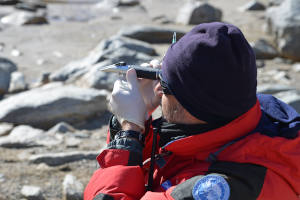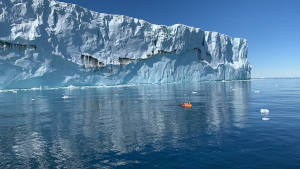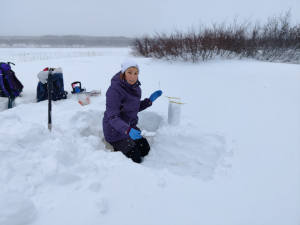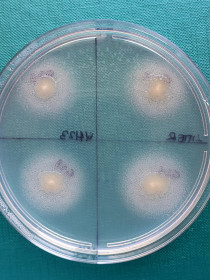 The Biosciences thematic area deals with the study of the biosphere in polar areas at different levels of biological complexity, from molecules to ecosystems and up to biomes. In particular, the attention is focused on the description and quantification of the biodiversity of the organisms that inhabit polar environments, to evaluate their structural and functional complexity. In this regard, scenarios of population shifts, changes in biodiversity and biogeochemical processes deriving from climate change and human impact are evaluated. The main interest is focused on the interactions between biological and ecological aspects, together with abiotic processes and effects on the carbon cycle and energy flows in the polar regions. Further fields of investigation concern the research of biomolecules of microbial origin, the ability of polar microorganisms to degrade organic contaminants and astrobiological aspects linked to life in extreme environments.
The Biosciences thematic area deals with the study of the biosphere in polar areas at different levels of biological complexity, from molecules to ecosystems and up to biomes. In particular, the attention is focused on the description and quantification of the biodiversity of the organisms that inhabit polar environments, to evaluate their structural and functional complexity. In this regard, scenarios of population shifts, changes in biodiversity and biogeochemical processes deriving from climate change and human impact are evaluated. The main interest is focused on the interactions between biological and ecological aspects, together with abiotic processes and effects on the carbon cycle and energy flows in the polar regions. Further fields of investigation concern the research of biomolecules of microbial origin, the ability of polar microorganisms to degrade organic contaminants and astrobiological aspects linked to life in extreme environments.
The central themes of the research carried out within the Biosciences Thematic Area are (1) structural and functional organization of polar ecosystems and dynamics of populations and communities; (2) response of individuals, populations and communities to external influences of climatic and anthropogenic origin (including loss and fragmentation of habitat, withdrawal, extraction, pollution, etc.); (3) biotechnological implications deriving from adaptation to low temperatures and/or other physical-chemical factors.
 Research objectives include:
Research objectives include:
• the study of structural and functional diversity and the ecophysiology of polar organisms, to shed light on the limits of adaptation, also in relation to climate change and human impacts;
• the study of biogeochemistry and ecology in marine and terrestrial habitats at the Poles, including the environmental factors controlling biological interactions;
• the estimation of the biotechnological potential of organisms adapted to life at low temperatures and/or other physical-chemical factors;
• the exploration of behavior and evolution of polar ecosystems, through spatial-temporal analyses of ecological processes;
• the management and conservation of polar marine resources;
• comparison between trends observed in polar areas and middle latitudes. The Thematic Area Biosciences is organized into the 4 sections, i.e. Biodiversity and adaptation, Biogeochemistry, Biotechnology and Astrobiology.
Main ERC Panels:
• LS8 - Environmental Biology, Ecology and Evolution
• LS9 - Biotechnology and Biosystems Engineering
• PE10 - Earth System Science
Referents: Angelina Lo Giudice, Mario La Mesa, Cairns Warren Raymond Lee
Contact: info-biosciences AT isp.cnr.it
Sub-themes
Biodiversity and adaptations
 Polar biological communities are generally subjected to the influence of various factors concomitant with low temperatures, such as dehydration, ice cover, low nutrient availability, exposure to harmful solar radiation (e.g. UV-B radiation), highly variable light periods and, in specific cases, high salinity and osmotic stress. Biodiversity guarantees the functioning of all ecosystems, so studying the properties and temporal evolution of polar ecosystems is a tool of fundamental importance for improving our knowledge on their current state and for making future predictions in relation to climatic change. The analysis and monitoring of the biodiversity of biological communities and their ecological dynamics constitute the focal point of this research topic. Of particular interest is the study of morphological-functional adaptation mechanisms adopted by polar organisms for survival in extreme conditions. Temporal processes and spatial patterns of greening are also considered through remote sensing technologies, especially as a response to the deepening of the active layer of the Arctic permafrost.
Polar biological communities are generally subjected to the influence of various factors concomitant with low temperatures, such as dehydration, ice cover, low nutrient availability, exposure to harmful solar radiation (e.g. UV-B radiation), highly variable light periods and, in specific cases, high salinity and osmotic stress. Biodiversity guarantees the functioning of all ecosystems, so studying the properties and temporal evolution of polar ecosystems is a tool of fundamental importance for improving our knowledge on their current state and for making future predictions in relation to climatic change. The analysis and monitoring of the biodiversity of biological communities and their ecological dynamics constitute the focal point of this research topic. Of particular interest is the study of morphological-functional adaptation mechanisms adopted by polar organisms for survival in extreme conditions. Temporal processes and spatial patterns of greening are also considered through remote sensing technologies, especially as a response to the deepening of the active layer of the Arctic permafrost.
 The growing human footprint in the polar regions, already made vulnerable by ongoing climate change, can have negative effects through pollution, habitat destruction, introduction and proliferation of invasive/alien species and overexploitation of resources. The study of the levels of contamination and of the potential for bioaccumulation and biomagnification in the food web makes it possible to provide integrated information on the ecosystem by identifying the hotspots in which species may be more vulnerable and sensitive to climate variability. Of interest is also the study of the colonization processes of plastic polymers, with structural and functional analysis of microbial biofilms (plastisphere) and their response to anthropic/natural forces.
The growing human footprint in the polar regions, already made vulnerable by ongoing climate change, can have negative effects through pollution, habitat destruction, introduction and proliferation of invasive/alien species and overexploitation of resources. The study of the levels of contamination and of the potential for bioaccumulation and biomagnification in the food web makes it possible to provide integrated information on the ecosystem by identifying the hotspots in which species may be more vulnerable and sensitive to climate variability. Of interest is also the study of the colonization processes of plastic polymers, with structural and functional analysis of microbial biofilms (plastisphere) and their response to anthropic/natural forces.
Main ERC Panels:
• LS8_1 - Ecosystem and community ecology, macroecology
• LS8_2 - Biodiversity
• LS8_5 - Biological aspects of environmental change, including climate change
• LS8_12 - Microbial ecology and evolution
• LS8_13 - Marine biology and ecology
• PE10-1 - Atmospheric chemistry, atmospheric composition, air pollution
• PE10_17 - Hydrology, hydrogeology, engineering and environmental geology, water and soil pollution

















